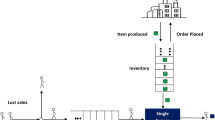Abstract
The production planning problem, that is, to determine the production rate of a factory in the future, requires an aggregate model for the production flow through a factory. The canonical model is the clearing function model based on the assumption that the local production rate instantaneously adjusts to the one given by the equilibrium relationship between production rate (flux) and work in progress (wip), for example, characterized by queueing theory. We will extend current theory and modeling for transient clearing functions by introducing a continuum description of the flow of product through the factory based on a partial differential equation model for the time evolution of the wip-density and the production velocity. It is shown that such a model improves the mismatch between models for transient production flows and discrete event simulations significantly compared to other clearing function approaches.





Similar content being viewed by others
References
Abate J, Whitt W (1991) Transient behavior of the M/G/1 workload process. Oper Res 42(4):750–764
Aouam T, Uzsoy R (2012) An exploratory analysis of production planning in the face of stochastic demand and workload-dependent lead times. In: Armbruster D, Kempf K (eds) Decision policies for production systems. Springer, London, pp 173–209
Armbruster D, Marthaler D, Ringhofer C, Kempf K, Jo T-C (2006) A continuum model for a re-entrant factory. Oper Res 54(5):933–950
Armbruster D, Marthaler D, Ringhofer C (2004) Kinetic and fluid model hierarchies for supply chains. SIAM Multiscale Model. Simul 2(1):43–61
Armbruster D (2012) The production planning problem: clearing functions, variable leads times, delay equations and partial differential equations. In: Armbruster D, Kempf K (eds) Decision policies for production systems. Springer, London, pp 289–302
Asmundsson JM, Rardin RL et al (2009) Production planning models with resources subject to congestion. Naval Res Logist 56:142–157
Berstimas D, Mourtzinou G (1997) Transient laws of non-stationary queueing systems and their applications. Queueing Syst 25:115–155
Bramson M (2008) Stability of queueing networks, lecture notes in mathematics, 1950. Springer, Berlin
Karmarkar US (1989) Capacity loading and release planning with work-in- progress (wip) and lead-times. J Manuf Oper Manag 2:105–123
Lighthill MJ, Whitham GB (1955) On kinematic waves. II. A theory of traffic flow on long crowded roads. Proc R Soc Lond A 229:317–345
Missbauer H (2010) Order release planning with clearing functions: a queueing-theoretical analysis of the clearing function concept. Int J Prod Econ. doi:10.1016/j.ijpe.2009.09.003
Wiendahl H-P (1995) Load oriented manufacturing control. Springer, Berlin
Acknowledgments
This project was started when D.A. was a part time professor at the Department of Mechanical Engineering, Eindhoven University of Technology. Helpful discussions with Erjen Lefeber and Ivo Adan on transient queueing models are gratefully acknowledged. Discussions with Hubert Missbauer and Reha Uzsoy helped to clarify the experiments on transient queuing and the relationship between clearing function models and the production planning problem. This research was supported by a grant from the Volkswagen Foundation under the program on Complex Networks.
Author information
Authors and Affiliations
Corresponding author
Rights and permissions
About this article
Cite this article
Armbruster, D., Fonteijn, J. & Wienke, M. Modeling production planning and transient clearing functions. Logist. Res. 5, 133–139 (2012). https://doi.org/10.1007/s12159-012-0087-8
Received:
Accepted:
Published:
Issue Date:
DOI: https://doi.org/10.1007/s12159-012-0087-8




